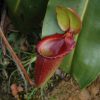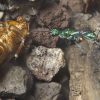Plants often evolve and adapt to their surroundings because, well, they have to – they don’t have claws to fend off predators, or legs to go find a meal. This seeming helplessness however, has given rise to some of Earth’s most complex and downright weird lifeforms: carnivorous plants!
Arguably the most impressive of carnivorous plants belongs to the pitcher plant family. Aptly named for their large ‘pitcher’-shaped leaves, these plants attract insects and small animals with a sweet smelling nectar, before trapping and drowning their prey in a pool of digestive juices.
These plants often grow in places where the soil is of low nutritious quality, and so rely on their carnivory to obtain necessary nutrients.
In 2007, Nepenthes rajah held the record for being the largest of pitcher plants. Sir David Attenborough explained its grotesque method of predation in his documentary series The Private life of Plants:
Every feature these plants possess is deadly. With traps disguised as sweet smelling flowers, the plant lures its prey with nectar. Once the insects and animals touch the pitchers however, the slippery walls and downward facing hairs mean that escape is near impossible. The visitors have no choice but to tumble into the fluid filled pit, where they either drown, or are actively dissolved and digested.
Nepenthes rajah were long thought to be the ‘King of the Pitcher Plants’. In 2009 however, a new species was catalogued, the largest and most impressive of all: Nepenthes attenbourghii or Attenborough’s pitcher plant.

This huge carnivore is described in an article on Encyclopædia Britannica:
“The endangered Attenborough’s pitcher plant (N. attenboroughii), is the largest carnivorous plant, reaching up to 1.5 metres (4.9 feet) tall. Its pitchers are 30 cm (11.8 inches) in diameter and are able to capture and digest rodents and other small animals.”
These monsters seem straight out of a fictional sci-fi world, and deserve the title of carnivore just as much as any other animal meat-eater.





